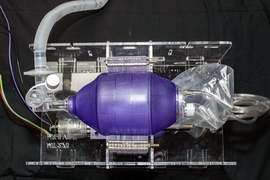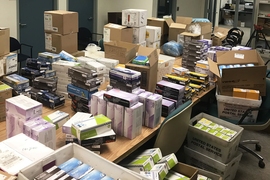Moving some 1,200 MIT subjects to a remote teaching and learning model, launched today, has been less like flipping a switch and more like building the switch itself — with whatever was on hand. In short, it’s a very MIT kind of problem.
In late February, before the coronavirus altered daily life and work in the U.S., Meghan Perdue, a digital learning lab fellow in Open Learning and an instructor in the School of Humanities, Arts and Social Sciences, noticed some rumblings on the horizon: Universities in Asia were switching to teaching online as the virus took hold there. She shared her concerns with Krishna Rajagopal, dean for digital learning, who, in turn, looped in Ian A. Waitz, vice chancellor for undergraduate and graduate education, and Sheryl Barnes, director of residential education in Open Learning. They began thinking, hypothetically, of how MIT could address such a challenging situation. With the help of other digital learning lab fellows across MIT, they began planning in earnest, designing online learning workshops and developing best practices.
In early March, as the outbreak appeared to be turning into a global pandemic, Waitz formed the Covid-19 Academic Continuity Working Group as part of a broader emergency management effort to ensure academic, residential life, research, and business continuity at MIT. From the get-go, he advocated a “pen-knife and matches” approach, with a focus on “thinking less about technology and more about how to put learning first” in the event, as has now happened, that most of the students, faculty, and instructors would be living and working off-campus.
Building the switch
With that in mind, as part of the working group, Rajagopal launched an intense and evolving effort that has drawn upon experts in the Teaching and Learning Lab (TLL), Open Learning, Information Systems and Technology (IS&T), and departments across MIT. It has been a monumental task: How do you go from a physical classroom like 10-250 to a multipaned Zoom window or video segments and online problems? How do you balance when to use real-time teaching with asynchronous? How do you support faculty and students along the way? And how do you do all this under the intense time constraints imposed by the ever-changing responses to Covid-19?
In short order, IS&T, TLL, and Open Learning have collaborated to build a teaching resource site that provides soup-to-nuts instructions on preparing classes for remote delivery. The site also focuses on best practices; ensuring equity, diversity and inclusion; and maintaining community; despite the fact that students are engaging from around the globe.
Meanwhile, Vice President for IS&T Mark Silis and his team have been at the ready to bolster and retool the Institute’s technical backbone to align with virtual learning. In addition to negotiating MIT-wide licenses for Zoom, Slack, Piazza, and Gradescope, and expanded Dropbox allocations for file storage, Silis says, “we are pleased to report that we launched a beta version of a Learning Tools Interoperability (LTI) program that will simplify the integration of Zoom, Piazza, and Gradescope with MIT’s Stellar and LMOD learning management environments for courses in which instructors plan to use live Zoom sessions for every class and recitation.” Rajagopal commented that IS&T’s “lightning-fast response to needs and never-say-impossible attitude has been astonishing.”
Equally adept at wrangling technology has been Sloan School of Management’s Wes Esser, Chief Technology Officer. Esser and his team have been eager to share their virtual learning expertise with the rest of the campus. Silis wrote in a blog post, “Sloan’s experience has been invaluable in their early embrace of the Zoom platform and its integration in the evolution of their academic programs. The ability to bring the Zoom platform to the entire MIT community within a matter of a few days, would simply not have been possible without our Sloan colleagues, and for that we all owe them a debt of thanks.”
Division of Student Life (DSL) also lent a hand, working with IS&T to ensure that students who needed access to technical tools to learn remotely, such as loaner laptops and Wi-Fi hotspots, would be ready for anything, from p-sets to office hours to live or recorded lectures.
One MIT
Throngs of faculty and other staff have come together to help make teaching and learning remote. Even before the decision was made to migrate to virtual instruction, faculty were on it, says Rajagopal. He had reached out to the instructional teams of the largest MIT classes to assess their readiness and to get a sense of how they were thinking about going remote. Appropriately, he says, “the response was magnificent and very MIT.” Faculty were already stepping up, with large economics, physics, and electrical engineering and computer science courses some of the first to make the switch.
For her part, Perdue has offered a steady drumbeat of workshops since early March to help faculty acclimate to teaching online. (To date, 15 two-hour workshops, and counting.) Likewise, two of Rajagopal’s key thought and action partners, Barnes and Janet Rankin, director of the Teaching and Learning Lab, have run webinars and fielded hundreds of questions about everything from how to build community in distributed learning environments, to team teaching, to creating video segments, to Zoom pedagogy. They turned their respective offices into tactical command centers, lending expertise and inspiration to faculty, instructors, and teaching assistants across campus.
Of course, not all modes of instruction translate easily to online platforms. “We also have labs, project classes, design classes, and performance classes and these will be a harder challenge,” Rajagopal says, “where instructors — and students — will need creativity and flexibility to achieve learning goals.” Some faculty have embraced these challenges early on. In 2.007, the iconic design and manufacturing course, professors Amos Winter and Maria Yang have worked to find creative solutions and silver linings, and planned for ways for students to build with at-hand materials. Likewise, in 8.13, the major lab class for physics juniors, Professor Gunther Roland was already confident that although students won’t be able to “twiddle the knobs,” they will achieve many of their learning goals via doing data analysis, writing a paper, and giving presentations.
Emma Teng, the T.T. and Wei Fong Chao Professor of Asian Civilizations, has been one of the many department leaders rallying her colleagues. “I feel my unit is prepared to begin the ‘best possible’ remote teaching on Monday,” she says. “We have the right policies, right technologies, right supports, and right spirit to enter into this endeavor. Not that there won’t be glitches, but after the experiences of the past two weeks people are ready to roll with the glitches as well!”
Expressing her gratitude to all those working behind the scenes to virtualize instruction, she says, “No one wished to find themselves in this place, but this group and so many others have worked tirelessly to make it the best it could possibly be.”
As collaboration has and will continue to be the key ingredient for success, Open Learning created an open community site for faculty to work together and share ideas and tips, which has seen lively traffic since it launched. Contributors have chimed in on topics like preventing Zoombombing (when interlopers disrupt an online class); how to conduct office hours and recitations; and even how to turn your cellphone into an overhead camera.
Staying connected to the Infinite — and each other
The parallel to remote teaching is, of course, remote learning. With that in mind, the Office of the Vice Chancellor (OVC) created a website for students which helps students navigate their new academic and social landscape. The website focuses on learning styles, well-being, and ensuring that classes still have that MIT feel. And in a letter to students Rajagopal and Waitz reminded students to be flexible too: “Don’t be surprised if you encounter a kid or two in the background, spouses and partners might pop in and out of view, as may pets, and everything will not always go according to plan.”
To help students stay connected, the Division of Student Life, OVC, and other campus partners are launching a collaborative effort to match every student with a Student Success Coach. Over 500 volunteers from across MIT have come forward to serve in this new support role. Through weekly one-on-one meetings, coaches will listen to how students are doing — as learners, and overall — and connect them to each other and to MIT in ways that will help them succeed.
“You can think of this as a way to keep students connected to the Infinite,” says Lauren Pouchak, director of special projects in the OVC, who is working with Elizabeth Cogliano Young, associate dean and director of the Office of the First Year, and Gus Burkett, senior associate dean in DSL. The three are leading an effort “to create a new kind of fabric, now that the physical campus is gone.”
And now that classes are underway, they and the hundreds of staff who helped implement remote learning at MIT can pause, briefly, and catch their collective breath. There is much more to be done. There will be hiccups along the way. And there will be unexpected lessons learned and opportunities, too.
“None of us have ever done this before, so we will navigate together,” says Rajagopal. “We will be making course corrections all the time. We will plan as we go, and then change our plan. We will be creative, flexible, and we will deliver to our students something that we can be proud of.”










